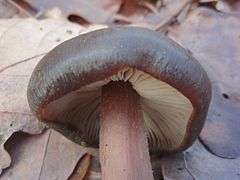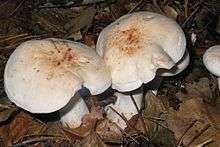Rhodocollybia
Rhodocollybia is a genus of Basidiomycete mushroom. Species in this genus, formerly classified as a subgenus in Collybia, have fairly large caps (typically larger than 5 centimetres (2.0 in) broad), and have a pinkish-tinted spore print. Microscopically, they are characterized by having spores and basidia that are dextrinoid—staining deep reddish to reddish-brown with Melzer's reagent when tested for amyloidity. Rhodocollybia species are commonly found in temperate North America and Europe, and infrequently in Central and South America.
| Rhodocollybia | |
|---|---|
 | |
| Rhodocollybia butyracea | |
| Scientific classification | |
| Kingdom: | |
| Division: | |
| Class: | |
| Order: | |
| Family: | |
| Genus: | Rhodocollybia |
| Type species | |
| Rhodocollybia maculata (Fr.) Singer | |
| Species | |
|
Approx. 30 species – see text. | |
Taxonomy
The genus name Rhodocollybia was first used by Rolf Singer in 1939 to describe those species of Collybia with a pink spore deposit;[1] in later works he considered the genera equivalent (synonymous) and called them Collybia.[2][3] In 1997, Antonín and Noordeloos studied various members of Collybia using phylogenetic analysis, and reorganized the genus, dividing species into either Collybia, Gymnopus, or Rhodocollybia.[4]
Description
The caps of species in this genus are relatively large, often more than 5 centimetres (2.0 in) in diameter, convex in shape but in maturity flattening, or often developing a shallow umbo–a mound in the center of the cap. The surface of the cap is often uneven, and slimy or slippery (lubricous) to the touch. The cap color can range from whitish to dark reddish brown. The gills are whitish to pinkish cream in color, and have an adnexed attachment to the stem. The stem is usually long and thick (relative to the cap diameter), often more than 7 centimetres (2.8 in) long and at least 0.5 centimetres (0.2 in) thick; the color usually whitish or the same color as the gills.[5] This type of agaric, collybioid mushroom has pale spore deposits which range from pinkish buff to pinkish cream.[6]
- Microscopic features
Spores in this species are typically spherical to ellipsoid in shape, and transclucent (hyaline). Rhodocollybia is characterized by having an endosporium (inner wall of the spore) that is dextrinoid (staining yellowish or reddish-brown in iodine-containing solutions such as Melzer's reagent), and sometimes cyanophilous.[7][8] The spore wall may be thin to thick (up to 0.5 µm).[5]
Habitat and distribution
Rhodocollybia species are found growing scattered to clustered together on forest duff or on well-rotted wood, in coniferous forests.[5] Species of Rhodocollybia can be found in various parts of the United States, including Maine, Hawaii,[9] and in California in conifer woods on needle duff or on rotting wood.[10] Species in this genus can also be found in such European countries as Poland and the Czech Republic. A 1989 work by mycologist Roy Halling reported three neotropical species: R. turpis from Colombia and Costa Rica, C. popayanica from Colombia, and C. sleumeri from Ecuador.[7]
Species

- Rhodocollybia amica[11]
- Rhodocollybia antioquiana[11]
- Rhodocollybia badiialba
- Rhodocollybia butyracea (Buttery Collybia)
- Rhodocollybia distorta
- Rhodocollybia dotae[11]
- Rhodocollybia extuberans
- Rhodocollybia filamentosa
- Rhodocollybia fodiens
- Rhodocollybia fusipes (= Gymnopus fusipes)
- Rhodocollybia giselae
- Found in the Mediterranean region of Europe (Italy and France), grows in thermophilous forests with Holm Oak (Quercus ilex), Strawberry trees, (Arbutus unedo) and Pine trees (genus Pinus).[12]
- Rhodocollybia incarnata[13]
- Rhodocollybia laulaha
- Rhodocollybia lentinoides
- Rhodocollybia lignitilis[11]
- Rhodocollybia longispora
- Rhodocollybia maculata (Spotted Toughshank)
- Rhodocollybia meridana
- Rhodocollybia monticola[11]
- Rhodocollybia oregonensis
- Rhodocollybia pandipes[11]
- Rhodocollybia popayanica[7]
- Rhodocollybia prolixa
- Rhodocollybia sleumeri[7]
- Rhodocollybia spissa
- Rhodocollybia stenosperma
- Rhodocollybia subnigra
- Rhodocollybia subsulcatipes
- Rhodocollybia tablensis[11]
- Rhodocollybia turpis
- Cap 8 to 11 centimetres (3.1 to 4.3 in) in diameter, light yellow in youth but turning pale orange with brown streaks and spots in maturity. Found in Colombia.[7]
- Rhodocollybia unakensis
See also
References
- Singer R. (1939). "Phylogenie und Taxonomie der Agaricales". Schweizerische Zeitschrift für Pilzkunde (in German). 17: 71–73.
- Singer R. (1986). The Agaricales in Modern Taxonomy. 4th ed. Koenigstein: Koeltz Scientific Books. ISBN 3-87429-254-1.
- Singer R. (1951). "The Agaricales in Modern Taxonomy". Lilloa. 22: 1–832.
- Antonín V, Noordeloos ME. (1997). A Monograph of Marasmius, Collybia and related general in Europe. IHW - Verlag: Eching, Germany. 256 p.
- Lennox JW. (1979). "Collybioid genera in the Pacific Northwest". Mycotaxon. 9 (1): 117–231.
- "California Fungi -- Agarics (Gilled Mushrooms)". Retrieved 2009-06-27.
- Halling RE. (1989). "Notes on Colybia III. Three neotropical species of subg. Rhodocollybia". Mycologia. Mycological Society of America. 81 (6): 870–75. doi:10.2307/3760105. JSTOR 3760105.
- "Rhodocollybia in NE USA". The New York Botanical Garden. Retrieved 2009-06-27.
- "Rhodocollybia laulaha". Agaricales of the Hawaiian Islands. Retrieved 2009-06-27.
- "California Fungi: Rhodocollybia badiialba". Retrieved 2009-06-27.
- Mata JL, Halling RE, Hughes KW, Petersen RH., Juan L.; Halling, Roy E.; Hughes, Karen W.; Petersen, Ronald H. (2004). "Rhodocollybia in neotropical forests". Mycological Progress. 3 (4): 337–51. doi:10.1007/s11557-006-0104-x.CS1 maint: multiple names: authors list (link)
- Antonin V, Neville P (1998). "Rhodocollybia giselae, a new species from the Mediterranean region in Europe". Czech Mycology. 50 (3): 181–84.
- Cooper J. (17 October 2014). "Nomenclatural novelties" (PDF). Index Fungorum. 193: 1.
Further reading
- Bas, C., Kyper, T.W., Noordeloos, M.E. & Vellinga, E.C. (1995). Flora Agaricina Neerlandica—Critical monographs on the families of agarics and boleti occurring in the Netherlands. Volume 3. Tricholomataceae. A. A. Balkema: Rotterdam, Netherlands. 183 p.
- Halling, R.E. (1983). The Genus Collybia (Agaricales) in the Northeastern United States and Adjacent Canada. J. Cramer: Braunschweig, Germany. 148 p.
- Desjardin, D. E., R. E. Halling & D. E. Hemmes (1999). Agaricales of the Hawaiian Islands. 5. The genera Rhodocollybia and Gymnopus. Mycologia 91